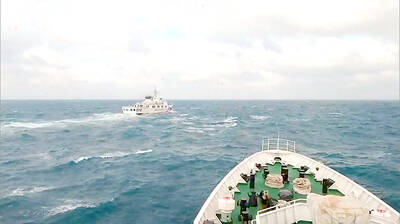In a reversal of a decision made earlier this year, Moscow has agreed to sell 24 Sukhoi Su-35BM fighter aircraft to China for an estimated US$1.5 billion, a sale that will further shift the balance of power in the air over the Taiwan Strait.
Russia’s Rosoboronexport and the Chinese Ministry of National Defense are said to have reached a preliminary agreement, with details discussed during a meeting in Beijing on Wednesday between Russian Minister of Defense Sergey Shoygu and Chinese President Hu Jintao (胡錦濤).
Hu was accompanied by General Xu Qiliang (許其亮), who was appointed one of the two vice chairmen of the Central Military Commission during the 17th session of the seventh plenary conference earlier this month.
The 24 aircraft come equipped with the 117S engine designed by Russian firm NPO Saturn, the Russian business daily Vedomosti reported.
The contract is expected to be signed next year or in 2014, with delivery of the jets starting in 2015.
Beijing has yet to confirm the deal.
Russian media reported earlier this year that Moscow had decided against selling China the 48 so-called “fourth-plus-plus generation” Su-35s, valued at more than US$4 billion, after Beijing requested them last year. Analysts concluded at the time that Russia’s principal reason for not selling the advanced multirole aircraft was the risk of Chinese reverse engineering. Beijing had initially only requested four.
Relations were already strained after China canceled an order for 95 Su-27s last year after it launched the production of the J-11, which Russia alleged was a replica of the Su-27.
The spat led to Moscow’s decision not to sell carrier-based Su-33 aircraft to the Chinese navy, which then designed its own version, the J-15, based on a single Su-33 it obtained from Ukraine.
The Russian air force is expected to take delivery of its first Su-35s in 2015.
China’s rapid modernization of its air force also includes the development of two types of fifth-generation “stealth” aircraft, the J-20 and J-31. It occurs at a time when Taiwan’s air force readies to retire its aging F-5 and Mirage-2000 aircraft.
According to a recent report by the US Congressional Research Service, the number of combat aircraft in Taiwan’s air force will drop by 70 percent in 2020 if no new aircraft are acquired, and by 50 percent if Taiwan procures the 66 F-16C/Ds it has unsuccessfully been requesting from the US since 2006.

Auckland rang in 2026 with a downtown fireworks display launched from New Zealand’s tallest structure, Sky Tower, making it the first major city to greet the new year at a celebration dampened by rain, while crowds in Taipei braved the elements to watch Taipei 101’s display. South Pacific countries are the first to bid farewell to 2025. Clocks struck midnight in Auckland, with a population of 1.7 million, 18 hours before the famous ball was to drop in New York’s Times Square. The five-minute display involved 3,500 fireworks launched from the 240m Sky Tower. Smaller community events were canceled across New Zealand’s

The Ministry of Foreign Affairs (MOFA) yesterday said it is closely monitoring developments in Venezuela, and would continue to cooperate with democratic allies and work together for regional and global security, stability, and prosperity. The remarks came after the US on Saturday launched a series of airstrikes in Venezuela and kidnapped Venezuelan President Nicolas Maduro, who was later flown to New York along with his wife. The pair face US charges related to drug trafficking and alleged cooperation with gangs designated as terrorist organizations. Maduro has denied the allegations. The ministry said that it is closely monitoring the political and economic situation

‘SLICING METHOD’: In the event of a blockade, the China Coast Guard would intercept Taiwanese ships while its navy would seek to deter foreign intervention China’s military drills around Taiwan this week signaled potential strategies to cut the nation off from energy supplies and foreign military assistance, a US think tank report said. The Chinese People’s Liberation Army (PLA) conducted what it called “Justice Mission 2025” exercises from Monday to Tuesday in five maritime zones and airspace around Taiwan, calling them a warning to “Taiwanese independence” forces. In a report released on Wednesday, the Institute for the Study of War said the exercises effectively simulated blocking shipping routes to major port cities, including Kaohsiung, Keelung and Hualien. Taiwan would be highly vulnerable under such a blockade, because it

UNRELENTING: China attempted cyberattacks on Taiwan’s critical infrastructure 2.63 million times per day last year, up from 1.23 million in 2023, the NSB said China’s cyberarmy has long engaged in cyberattacks against Taiwan’s critical infrastructure, employing diverse and evolving tactics, the National Security Bureau (NSB) said yesterday, adding that cyberattacks on critical energy infrastructure last year increased 10-fold compared with the previous year. The NSB yesterday released a report titled Analysis on China’s Cyber Threats to Taiwan’s Critical Infrastructure in 2025, outlining the number of cyberattacks, major tactics and hacker groups. Taiwan’s national intelligence community identified a large number of cybersecurity incidents last year, the bureau said in a statement. China’s cyberarmy last year launched an average of 2.63 million intrusion attempts per day targeting Taiwan’s critical